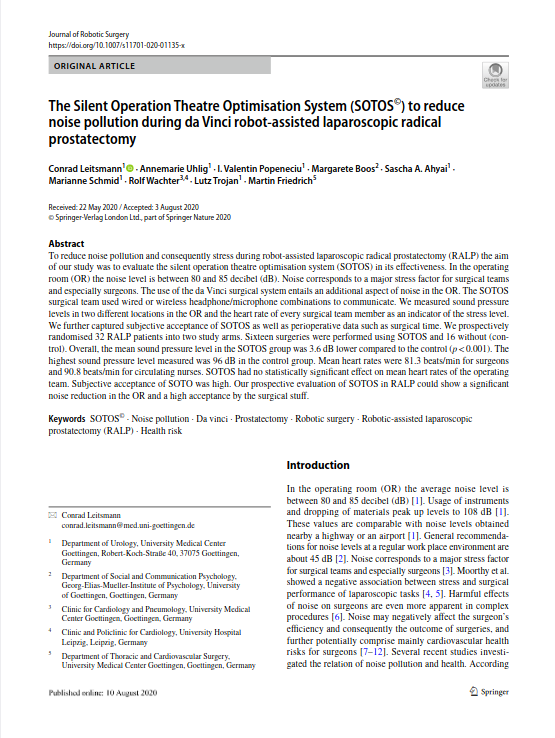The Silent Operation Theatre Optimisation System (SOTOS©) to reduce noise pollution during da Vinci robot‑assisted laparoscopic radical prostatectomy
 Abstract
Abstract
To reduce noise pollution and consequently stress during robot-assisted laparoscopic radical prostatectomy (RALP) the aim of our study was to evaluate the silent operation theatre optimisation system (SOTOS) in its effectiveness. In the operating room (OR) the noise level is between 80 and 85 decibel (dB). Noise corresponds to a major stress factor for surgical teams and especially surgeons. The use of the da Vinci surgical system entails an additional aspect of noise in the OR. The SOTOS surgical team used wired or wireless headphone/microphone combinations to communicate. We measured sound pressure levels in two different locations in the OR and the heart rate of every surgical team member as an indicator of the stress level. We further captured subjective acceptance of SOTOS as well as perioperative data such as surgical time. We prospectively randomised 32 RALP patients into two study arms. Sixteen surgeries were performed using SOTOS and 16 without (con-trol). Overall, the mean sound pressure level in the SOTOS group was 3.6 dB lower compared to the control (p < 0.001). The highest sound pressure level measured was 96 dB in the control group. Mean heart rates were 81.3 beats/min for surgeons and 90.8 beats/min for circulating nurses. SOTOS had no statistically significant effect on mean heart rates of the operating team. Subjective acceptance of SOTO was high. Our prospective evaluation of SOTOS in RALP could show a significant noise reduction in the OR and a high acceptance by the surgical stuff.AbstractTo reduce noise pollution and consequently stress during robot-assisted laparoscopic radical prostatectomy (RALP) the aim of our study was to evaluate the silent operation theatre optimisation system (SOTOS) in its effectiveness. In the operating room (OR) the noise level is between 80 and 85 decibel (dB). Noise corresponds to a major stress factor for surgical teams and especially surgeons. The use of the da Vinci surgical system entails an additional aspect of noise in the OR. The SOTOS surgical team used wired or wireless headphone/microphone combinations to communicate. We measured sound pressure levels in two different locations in the OR and the heart rate of every surgical team member as an indicator of the stress level. We further captured subjective acceptance of SOTOS as well as perioperative data such as surgical time. We prospectively randomised 32 RALP patients into two study arms. Sixteen surgeries were performed using SOTOS and 16 without (con-trol). Overall, the mean sound pressure level in the SOTOS group was 3.6 dB lower compared to the control (p < 0.001). The highest sound pressure level measured was 96 dB in the control group. Mean heart rates were 81.3 beats/min for surgeons and 90.8 beats/min for circulating nurses. SOTOS had no statistically significant effect on mean heart rates of the operating team. Subjective acceptance of SOTO was high. Our prospective evaluation of SOTOS in RALP could show a significant noise reduction in the OR and a high acceptance by the surgical stuff.
File: Type PDF / Size: 1 MB/ Download
